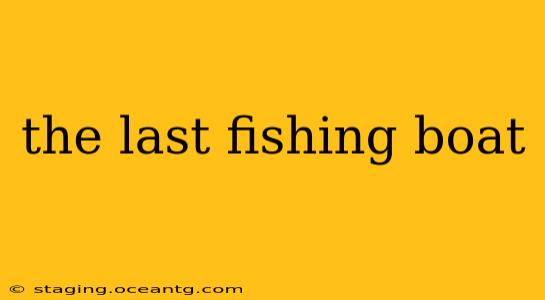The image of a lone fishing boat on a vast ocean, silhouetted against a setting sun, evokes a sense of both romance and impending loss. This image perfectly encapsulates the plight of many fishing communities worldwide, facing the harsh realities of dwindling fish stocks, overfishing, and climate change. This article explores the challenges facing the fishing industry, focusing on the potential disappearance of the "last fishing boat" and what we can do to prevent it.
What are the biggest threats to the fishing industry?
The fishing industry faces a multitude of interconnected threats. Overfishing is perhaps the most significant, depleting fish populations faster than they can replenish. This is exacerbated by unsustainable fishing practices, such as destructive bottom trawling which damages vital marine habitats. Climate change also plays a crucial role, altering ocean currents, water temperatures, and the distribution of fish species, making it harder for fishermen to find their traditional catches. Pollution from plastics and other sources further contaminates the marine environment, harming fish populations and rendering some catches unsafe for consumption. Finally, economic pressures, including rising fuel costs and fluctuating market prices, add further strain on already struggling fishing businesses.
Why is it important to save small-scale fishing communities?
Small-scale fishing communities are often the backbone of coastal economies, providing livelihoods for millions and contributing significantly to food security, particularly in developing nations. The loss of these communities would have far-reaching consequences, including increased food insecurity, economic hardship, and the loss of traditional knowledge and cultural heritage intimately tied to fishing. Preserving these communities isn't just about saving jobs; it's about protecting biodiversity, maintaining sustainable fishing practices, and upholding cultural traditions.
How is climate change impacting the fishing industry?
Climate change is dramatically altering marine ecosystems. Rising ocean temperatures lead to coral bleaching and the displacement of fish stocks, forcing fishermen to travel farther and expend more resources to find their catches. Changes in ocean currents can disrupt migration patterns, making it difficult to predict where fish will be. Increased ocean acidification, caused by the absorption of carbon dioxide, also harms shellfish and other marine life, further impacting the overall health of the ecosystem. These combined effects put immense pressure on fishing communities and threaten their long-term sustainability.
What solutions are available to ensure the future of fishing?
Addressing the challenges facing the fishing industry requires a multi-pronged approach. Implementing sustainable fishing practices, including stricter quotas, better enforcement of regulations, and the promotion of selective fishing gear, is crucial. Marine Protected Areas (MPAs) can help replenish fish stocks and protect vital habitats. Investing in research to better understand the impacts of climate change on fish populations is vital for adapting to future challenges. Furthermore, supporting small-scale fishing communities through fair trade practices, access to credit, and capacity building ensures their resilience. Consumer awareness and responsible seafood choices also play a significant role in promoting sustainable practices.
What can consumers do to help protect the fishing industry?
Consumers can make a significant difference by making informed choices about the seafood they purchase. Look for certifications from reputable organizations that ensure sustainable fishing practices, such as the Marine Stewardship Council (MSC). Choose locally sourced seafood whenever possible, supporting local fishermen and reducing the environmental impact of transportation. Reducing our overall consumption of seafood, particularly species that are overfished, also helps lessen the pressure on fish stocks. Advocating for stronger regulations and supporting organizations working to protect marine ecosystems further contribute to creating a sustainable future for the fishing industry.
The "last fishing boat" may seem like a metaphorical image, but it represents a very real threat. By addressing overfishing, climate change, and other challenges facing the industry through collaborative efforts, we can ensure a future where fishing communities thrive and the ocean remains a source of sustenance and wonder for generations to come. The survival of these communities is not only crucial for economic and food security but also for the preservation of our planet's invaluable marine resources.
